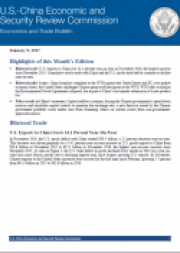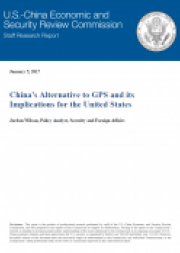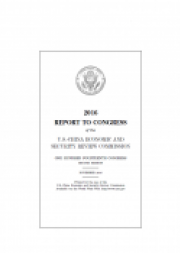Announcements
04/18/2016
This hearing will examine China’s fiscal and financial reforms, implementation of China’s high-tech industrial policy in the automobile, aviation, and semiconductor sectors, efforts to improve citizens’ quality of life, and the implications these reforms and policies have for U.S. economic and national security interests.
04/12/2016
From December 2013 to October 2015, China built artificial islands with a total area of close to 3,000 acres on seven coral reefs it occupies in the Spratly Islands in the southern part of the South China Sea. Although dredging, land reclamation, and the building of artificial islands are not unique to China, the scale and speed of China’s activities, the biodiversity of the area, and the significance of the Spratly Islands to the ecology of the region make China’s actions of particular concern. In addition to damage to the reefs, China’s island building activities have negatively impacted fisheries in the immediate area of the reclamation sites, and could negatively impact the health of fisheries in the coastal areas of the South China Sea. The building of these artificial islands will almost certainly lead to increased Chinese fishing in the surrounding waters, which could raise the risk of a clash between Chinese fishing boats and those of other claimant countries. Moreover, China’s island building activities may have violated some of its environmental commitments under international law; the ongoing case initiated by the Philippines at the Permanent Court of Arbitration in The Hague regarding China’s claims and activities in the South China Sea is considering this possibility.
04/05/2016
Highlights of this Month’s Edition: • Bilateral trade: U.S. trade deficit with China down in February 2016 on weaker exports and imports. • Bilateral policy issues: Department of Commerce announces, then temporarily lifts, sanctions against Chinese telecommunications firm ZTE for violating U.S. export controls. • Policy trends in China’s economy: Chinese government floats new plans to eliminate mounting debt. • 13th Five-Year Plan: Chinese government’s blueprint for the country’s development in 2016–2020 outlines plans for continued economic rebalancing, accelerated urbanization, domestic industrial upgrading, and green development.
03/31/2016
This hearing will examine the origins, implementation, and impacts of the U.S. “Rebalance to Asia” strategy, now in its fourth year. It will assess the reactions of China and other regional countries to the Rebalance, and evaluate areas of strength and weakness. The hearing will also explore what objectives and policies will best serve U.S. regional interests moving into a new Administration.
03/24/2016
This hearing will examine the origins, implementation, and impacts of the U.S. “Rebalance to Asia” strategy, now in its fourth year. It will assess the reactions of China and other regional countries to the Rebalance, and evaluate areas of strength and weakness. The hearing will also explore what objectives and policies will best serve U.S. regional interests moving into a new Administration.
03/15/2016
While the People’s liberation Army continues to build anti-access/area denial capabilities to deter or delay a U.S. military response to a potential conflict with China, Beijing also appears to be pursuing other options—including nonmilitary options prior to a conflict—likely intended to erode the United States’ strategic position, freedom of action, and operational space in the Asia Pacific. The nonmilitary options being pursued include engagement, coercion, and alliance splitting focused on U.S. allies and partners in the Asia Pacific region. Although Beijing’s attempts to limit U.S. force projection capabilities in Asia through these efforts have produced mixed results, there is little indication Beijing will abandon its efforts to mitigate the U.S. military presence in the region.



